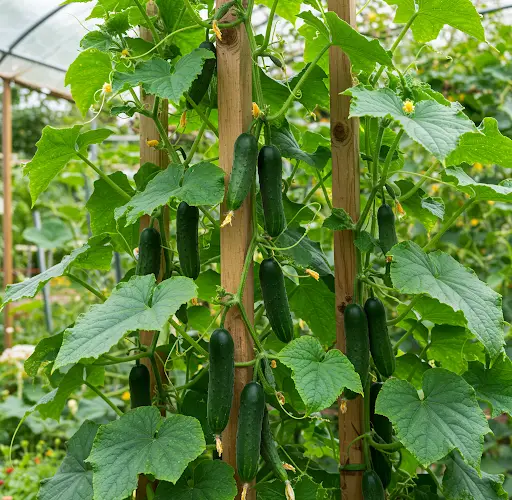How to Grow Cucumbers Vertically for an Abundant Harvest
Growing cucumbers vertically is an excellent method to maximize space, promote healthier plants, and increase fruit production. Vertical gardening allows cucumbers to grow upwards instead of sprawling on the ground, reducing disease and pest issues. In this guide, you will learn step-by-step how to cultivate cucumbers vertically for an extremely high yield.
Why Grow Cucumbers Vertically?
Growing cucumbers on trellises, stakes, or other vertical supports offers several benefits:
- Space Efficiency: Ideal for small gardens and container growing.
- Improved Air Circulation: Reduces fungal infections and diseases.
- Easier Harvesting: Cucumbers hang neatly, making them easy to pick.
- Higher Yields: Plants focus on fruit production instead of sprawling growth.
- Better Sun Exposure: Leaves and fruit receive optimal sunlight.
Step-by-Step Guide to Growing Cucumbers Vertically
1. Choosing the Right Cucumber Variety
Select vining cucumber varieties instead of bush types. Some popular options include:
- Marketmore 76
- Straight Eight
- Boston Pickling
- Poinsett 76
- Lemon Cucumber
These varieties grow well on trellises and produce an abundance of fruit.
2. Selecting the Right Location
Cucumbers thrive in full sun, requiring at least 6-8 hours of sunlight daily. Choose a well-drained area with nutrient-rich soil. If growing in containers, ensure they are placed in a sunny location.
3. Preparing the Soil
Cucumbers grow best in fertile, loamy soil with a pH between 6.0 and 7.0. Follow these steps for optimal soil preparation:
- Mix compost or well-rotted manure into the soil.
- Ensure the soil is loose and well-aerated.
- Add organic matter to improve moisture retention.
4. Choosing a Vertical Support System
There are several options for supporting cucumber plants:
- Trellises: Install a sturdy trellis made of wood, wire, or bamboo.
- Cages: Tomato cages can support cucumber vines.
- Netting or String Supports: Use garden netting attached to poles.
- Arches: Growing cucumbers on an arched trellis creates an attractive garden feature.
Install the support system before planting to avoid disturbing young roots later.
5. Planting Cucumber Seeds or Seedlings
- If sowing seeds directly, plant them 1 inch deep and 6 inches apart.
- If using seedlings, transplant them when they are 3-4 weeks old.
- Space rows at least 12-18 inches apart to allow airflow.
6. Watering and Mulching
Cucumbers require consistent moisture for proper growth. Keep the soil evenly moist by watering deeply at least 2-3 times per week. Avoid overhead watering to prevent fungal diseases.
Mulching is essential to retain moisture and suppress weeds. Use organic mulch like straw, leaves, or grass clippings around the base of plants.
7. Fertilizing for Maximum Growth
To ensure a high yield, feed your cucumber plants regularly:
- Apply a balanced fertilizer (10-10-10) at planting.
- Once flowering begins, switch to a phosphorus-rich fertilizer to boost fruit production.
- Use compost tea or organic fertilizers like fish emulsion every 2-3 weeks.
8. Training and Pruning the Vines
Once the vines start growing, train them to climb the support structure by gently tying them with soft twine or garden clips. Avoid damaging the stems.
Prune the lower leaves and side shoots to improve airflow and direct energy toward fruiting. Removing excess foliage prevents disease buildup and promotes healthy fruit growth.
9. Pest and Disease Control
Monitor plants regularly for pests like aphids, spider mites, and cucumber beetles. Use organic pest control methods:
- Spray neem oil or insecticidal soap to deter insects.
- Introduce beneficial insects like ladybugs to control pests.
- Rotate crops yearly to prevent soil-borne diseases.
Common diseases such as powdery mildew and downy mildew can be prevented by proper spacing, pruning, and using disease-resistant varieties.
10. Harvesting Cucumbers for Maximum Yield
Cucumbers are ready to harvest 50-70 days after planting. Pick them when they are firm, bright green, and about 6-8 inches long (depending on the variety).
- Harvest regularly to encourage more fruit production.
- Use scissors or a sharp knife to avoid damaging the vines.
11. Extending the Growing Season
To keep harvesting cucumbers longer:
- Plant in succession every 2-3 weeks.
- Use row covers to protect against early frost.
- Grow cucumbers in greenhouses or indoor spaces during colder months.
Conclusion
Growing cucumbers vertically is a game-changer for home gardeners. By choosing the right variety, using a strong support system, and maintaining optimal growing conditions, you can enjoy an abundant harvest of fresh, delicious cucumbers. Try this method in your garden and never run out of cucumbers again!



